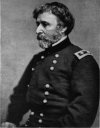The Battle of Lexington: Prologue

 On August 10, 1861, a coalition of forces from the Missouri State Guard, Arkansas State Troops and the Confederate States of America had defeated the Union Army of the West at the Battle of Wilson's Creek. Buoyed by this victory, Major General Sterling Price, commander of the Missouri State Guard, had argued passionately for this coalition to continue north and retake the State of Missouri for the southern cause. However, Brigadier Benjamin McCulloch, commander of the Confederate forces, was unwilling to move north, further and further away from his bases of supply. While McCulloch withdrew south, Price headed north with his Missouri State Guard forces. His destination was Lexington, Missouri.
On August 10, 1861, a coalition of forces from the Missouri State Guard, Arkansas State Troops and the Confederate States of America had defeated the Union Army of the West at the Battle of Wilson's Creek. Buoyed by this victory, Major General Sterling Price, commander of the Missouri State Guard, had argued passionately for this coalition to continue north and retake the State of Missouri for the southern cause. However, Brigadier Benjamin McCulloch, commander of the Confederate forces, was unwilling to move north, further and further away from his bases of supply. While McCulloch withdrew south, Price headed north with his Missouri State Guard forces. His destination was Lexington, Missouri.
Lexington, Missouri is located in Lafayette County in the west central part of the state on bluffs overlooking the Missouri River. At the time of the American Civil War, Lexington was a prosperous town and was the second (third?) largest port on the Missouri River after St. Louis. According to the 1860 census, Lexington was Missouri's fifth largest town with a population of 4,122. In 1860, Lafayette County had a total population of 20,098 making it the fourth most populous county in Missouri. Lafayette County's slave population of 6,374 was the largest of any county in the State of Missouri.
As far as Price was concerned, Lexington was a strategic location in the struggle for Missouri. The Union commanders in Missouri had established garrisons at key points along the Missouri River from St. Louis to St. Joseph, Missouri. In doing so the Union was able to prevent northern Missourians sympathetic to the South from crossing the river to join up with Price's Missouri State Guard. Price believed capturing Lexington would allow thousands of Missourians to join in support of the Southern cause.
 Price also wanted to get his hands on the money due his Missouri State Guard that was deposited in the Farmer's Bank of Lexington. Of the $900,000 on deposit in the bank, $37,000 had been earmarked to support the operations of the Missouri State Guard. The Union Commander in Missouri, Major General John Charles Fremont, had been impounding bank deposits throughout the state, but had yet to impound the money in Lexington.
Price also wanted to get his hands on the money due his Missouri State Guard that was deposited in the Farmer's Bank of Lexington. Of the $900,000 on deposit in the bank, $37,000 had been earmarked to support the operations of the Missouri State Guard. The Union Commander in Missouri, Major General John Charles Fremont, had been impounding bank deposits throughout the state, but had yet to impound the money in Lexington.
On August 25, 1861, Price left Springfield, Missouri and headed for Lexington with approximately 8,000 troops in his Missouri State Guard army.
